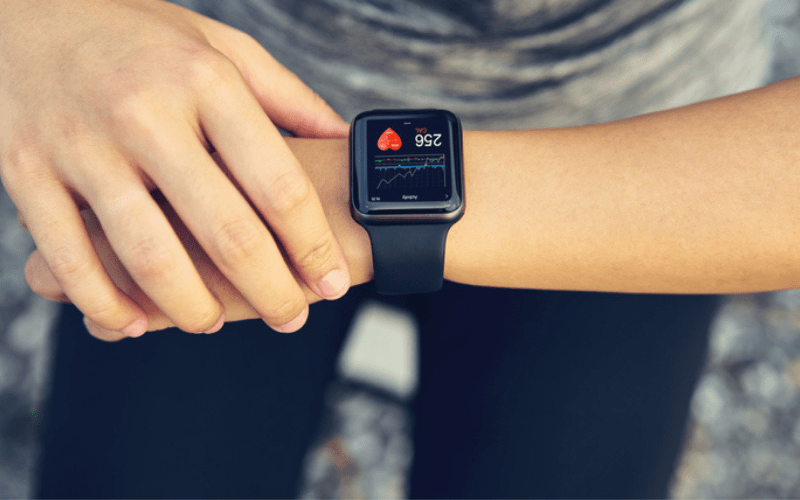
Coronavirus – conference rescheduled
Lifestyle Medicine 2020 will now be held 4-6 December 2020 at the same venue (Pullman Albert Park) in Melbourne.

The watch has been propelled into a new era by ‘smart’ technology. In the age of the omnipresent cellphone, the humble portable timepiece rapidly became more a fashion statement than a practicality. Now, smartwatches are sold as both an extension of the aforementioned cellphone as well as a ‘tracker’ of health, meticulously and incessantly measuring our movements and everything from our oxygen saturations to hours of sleep.
Smartwatches are a wonderful marketing proposition: our cellphones are our most loyal companions, and we love collecting information (particularly about ourselves). What’s better than also being told our gadgets will benefit our health? About half a billion smartwatches have already shipped worldwide, and global sales are expected to rise to over 250 million units a year by 2025. But is the smartwatch really improving our health?
First, let’s look at what they offer. The top three smartwatches are the Apple Watch, Fitbit Versa, and Samsung Galaxy. All record activity (and calories burned), heart rate, heart rate variability, oxygen saturation, and sleep. The Apple and Samsung watches both measure a single lead ECG which can detect atrial fibrillation. The Galaxy claims to be able to measure your body composition by bioelectrical impedance analysis as well as blood pressure (if calibrated with a blood pressure cuff).
All watches have a variety of other health features that may certainly be of some interest and value to individual users. I would argue the most important of these is fall detection which is oddly only featured by Apple and Samsung. All three watches display notifications and can respond to messages and calls from your phone.
Extrapolating from the little research available on fitness trackers, their accuracy is variable. Ironically, it appears ‘fitness tracking’ smartwatches perform less accurately the more active you are. They are good at counting steps when you are walking, but less so if you are engaging in moderate to intense physical activity1. They tend to take more accurate measurements of your heart rate when you are at rest than when you are exercising2.
And even if we don’t mind wearing a watch while we sleep, sleep tracking is not straightforward even with the ‘gold standard’ polysomno graph, so inevitably smartwatches are least accurate at this3. Ultimately, a more important consideration than accuracy (which presumably will continually improve with technological advancements) are the implications of the data being collected
Law 10 of The House of God is ‘if you don’t take a temperature, you can’t find a fever’4. Although seemingly facetious, there is great wisdom in not looking for problems when none exist. A significant drawback of smartwatch ‘health tracking’ is that it encourages exactly this. ‘False positives’ cause significant anxiety, as can large amounts of data and measurements of uncertain utility.
Although manufacturers are highly incentivized to offer more and more measurements via smartwatches, the more we measure, the higher the probability we will discover abnormal results. Smartwatch wearers are overwhelmingly fit and young (well over half of wearers are aged 15 to 34), so recently added features like oxygen saturation measurement and atrial fibrillation detection are much more likely to be a source of anxiety than relevant data.
A recent article by The Verge interviewed cardiologists, sleep doctors, and sports physicians about how their interactions with patients had changed in the smartwatch era5. All cited problems with interpretation of so much data and discussed the anxiety it could provoke for wearers.
A cardiologist estimated that a third of those who came in worried about a smartwatch notification had a false positive reading. A sleep doctor explained that it can be hard to treat someone who has sleep issues if they are fixated on data from a device. While this is the domain that smartwatches are least helpful with measuring, sleep is easily impacted by anxiety about the measurements generated.
Sleep specialist Dr Roger Seheult recently explained on the Feel Better Live More podcast that 90% of what he deals with in patients he sees with insomnia is the problem of anxiety about the fact that they can’t sleep6. Smartwatches encourage anxiety about not only sleep onset and duration, but also sleep quality; something they do not measure well at all.
One particular sports medicine specialist makes an important observation when discussing her experience with athletes who use smartwatches. She says “they’re always looking at their watch and trying to fix something. They spend so much time setting everything up or tracking it after, rather than focusing on why they’re exercising, or other things that might make them better performers.”5
Smartwatches encourage us to focus specifically on the metrics they are capable of measuring, and on behaviours that improve these metrics. What smartwatches are able to measure is dictated by what we have the technology to easily measure as well as what is marketable, rather than what is empirically demonstrated to be best for health. Naturally this can distract from other healthy (or even healthier) behaviours that are not (or cannot be) measured.
The better part of my career in medicine has been dedicated to increasing awareness of the central importance of the foods we choose to eat in all aspects of our short and long-term health. Smartwatch technology at best marginalises and at worst encourages ignorance of the critical and more important impact diet has on one’s health than one’s activity levels do. This shouldn’t be a zero-sum game, but increasingly common anecdotes of very fit and well young people having cardiac events demonstrate that it can be.
Smartwatches are designed to connect seamlessly and automatically with our cellphones. The default setting is for everything from incoming calls, messages, and even email or notifications from applications on phones to be displayed on the smartwatch. The smartwatch we are wearing alerts us visually, aurally, or tactually (often all three) the very second we receive any of these communications. This connects us continuously with our cellphone that previously we might have checked only intermittently.
Unfortunately, we cannot help but be distracted by these interruptions, ultimately leading to a loss of focus and almost certainly reduced productivity, and consequently a likely increase in our stress levels. Nearly 20 years ago and well before smartwatches became commonplace, research showed office workers were already being interrupted every 3 to 5 minutes (half of the time by communication alerts) and that it would often take as much as 20 minutes to return to their work following these interruptions7.
Smartwatches usually add their own well-intentioned ‘reminders’ to exercise, stand, or relax during the day too. Personally, I find these irritating, because even if you aren’t trying to stay focussed at the time, they tend to pop up in situations where you have good reason not to be doing any of these three things (think a work meeting that has run overtime, for example). So, they tend just to serve as a frustrating reminder of how suboptimal the realities of our day-to-day lives are for our health and wellbeing.
Of course, you can turn alerts and reminders off and if you have asked not to be disturbed by your cellphone this should transfer across to your smartwatch. No doubt this is something a growing number of us will be aware of. Nonetheless, default settings are powerful ‘nudges’ and most smartwatches will be left on default.
Despite their limitations, smartwatches and wearable devices certainly have potential to be adapted and applied in ways that could benefit our health. As is typical of medicine, this might especially be the case if they were used by certain groups of people at a higher risk (e.g. fall or arrhythmia alerts in older people with risk factors) rather than deploying the solution across the whole population. Manufacturers of smartwatches could use the information we have already established about human behaviour and health to design a device that takes a more holistic approach to health tracking and addresses many of the aforementioned limitations.
For some users, with knowledge of their current limitations, smartwatches may already be used in a fashion that is more a help than a hinderance. I did find that the visual representation of my progress towards my ‘activity goal’ while I was wearing one provided motivation and a reminder to exercise more, which is seldom going to be a bad thing.
That being said, a powerful argument can be made for keeping things simple. People were living long, healthy, and fulfilling lives (sometimes to a much greater degree than we do in our modern societies) long before these technologies became available. There are environmental and opportunity costs to anything new we purchase, and to survive as a species we need to simplify our lives and reduce consumption. While a high-quality conventional watch might have previously lasted decades or even generations, smartwatches have, and are intended to have, a much shorter lifespan.
Perhaps we should, as health practitioners and a society, reject and discourage endless ‘advances’ in ‘health’ technology unless they clearly improve our quality and quantity of life – in which case, the smartwatch probably isn’t the answer.
This article has been written for the Australasian Society of Lifestyle Medicine (ASLM) by the documented original author. The views and opinions expressed in this article are solely those of the original author and do not necessarily represent the views and opinions of the ASLM or its Board.

Lifestyle Medicine 2020 will now be held 4-6 December 2020 at the same venue (Pullman Albert Park) in Melbourne.
The Australasian Society of Lifestyle Medicine acknowledges Aboriginal and Torres Strait Islander peoples as the Traditional Custodians of the unceded lands and waters where we live and work. We celebrate their ongoing connection to land, sea and culture and pay our respects to Elders past, present and emerging. As a bi-national (or Australasian) society, we also acknowledge ngā iwi Māori as the Tangata Whenua (or people of the land) of Aotearoa. We are committed to upholding the principles of the Te Tiriti o Waitangi, building our relationship with Māori, and working together to improve the health of all First Nations peoples.
There was a problem reporting this post.
Please confirm you want to block this member.
You will no longer be able to:
Please note: This action will also remove this member from your connections and send a report to the site admin. Please allow a few minutes for this process to complete.
